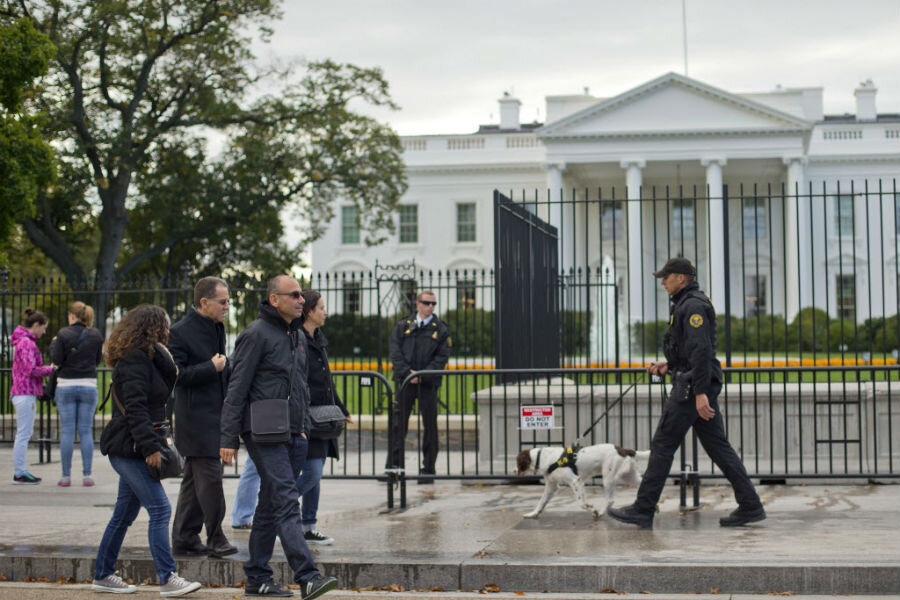Secret Service plans taller White House fence. Will that block jumpers?
Loading...
| Washington
Would a taller White House fence deter potential jumpers from trying to illegally enter executive mansion grounds? The Secret Service thinks so – and it’s working with the Park Service on plans to raise the existing wrought-iron barrier.
That’s what Acting Secret Service Director Joseph Clancy told the House Judiciary Committee on Wednesday. It was his first major public appearance since replacing director Julia Pierson following her resignation in October.
“A higher fence would certainly help us and we’re looking for ways and options [to build one],” said Mr. Clancy. “In fact, we hope within the next few months to have some renderings, some drawings of some options for people to look at.”
Fence-jumping has been a huge problem for the Secret Service this year, of course. On Sept. 19, a Texas Army veteran named Omar Gonzalez scaled the barrier and made it all the way into the East Room before he was subdued. The flubs that allowed Mr. Gonzalez to make it that far, on top of previous revelations of laxity and scandalous behavior within the once-proud protection agency, cost Ms. Pierson lost her job.
Then on Oct. 22, a Bel Air, Md., man named Dominic Adesanya also jumped the White House fence. Secret Service dogs quickly corralled this intruder.
In recent weeks, lots of commentators have suggested that a taller fence might stop these people. After all, it’s been about the same height since 1965, when the Park Service (which has jurisdiction on the White House grounds) replaced an 18th-century wrought iron fence with something about eight inches taller.
Since then the fence has been tweaked a bit to make it more intruder-resistant. In 1976, old gates were replaced with reinforced steel barriers meant to withstand the impact from ramming cars, according to a timeline produced by the White House Historical Association.
In 1983, concrete jersey barriers were scattered around the White House perimeter in response to the deadly truck bombing at the US Marine barracks in Beirut, Lebanon. In 1995, Pennsylvania Avenue in front of the White House was shut to traffic following the destruction of the federal building in Oklahoma City.
But the White House fence is still 7 feet, 6 inches tall. Is it possible to make that, say, ten feet tall, without destroying the artistic integrity of the grounds, or giving downtown Washington the appearance of an armed camp? Local residents complain about the gradual Kremlin-ification of the White House neighborhood, caused by expanding no-go zones for cars and the spread of concrete bollards.
At Wednesday’s hearing, Clancy noted that the Secret Service has to work with the Park Service, the National Capital Regional Planning Commission, and the Commission of Fine Arts in regards to protective measures at the White House.
“We have already started those discussions to work together to see if there’s something that is amenable to all the groups so that we keep the historic nature of the White House, but also increase the security measures at the house,” Clancy told lawmakers.
The reputation of the Secret Service could go even lower if more jumpers make it more than a few feet into the White House grounds. Clancy admitted that the agency had already been “severely damaged” by past blunders.
One easy fix the agency might make is to ensure the fence is in good repair. According to the executive summary of a Department of Homeland Security review of the Sept. 19 fence-jumper incident, Gonzalez scaled a section of the fence where ornamental spike, referred to as a “trident,” was missing.
Such spikes are decorative but also meant to make it difficult for an intruder to make it over the fence top.
Thicker bushes – or thorn bushes – might help, too. After making it over the fence, Gonzalez sprinted up the North Lawn and then plunged into a thicket of six-to-eight-foot tall bushes planted in front of the White House North Portico.
Pursuing officers lost sight of him as they circled around the bushes, which they believed to be too thick to run through. They were wrong. Gonzalez scrambled out the other side and into the actual White House before they caught him.
“Both Emergency Response Team Officers were surprised that Gonzalez was able to get through the bushes; prior to that evening the Officers believed the bushes too thick to be passable,” said the DHS report.








